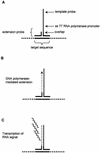Evaluation of an isothermal signal amplification method for rapid detection of methicillin-resistant Staphylococcus aureus from patient-screening swabs
- PMID: 12843062
- PMCID: PMC165283
- DOI: 10.1128/JCM.41.7.3187-3191.2003
Evaluation of an isothermal signal amplification method for rapid detection of methicillin-resistant Staphylococcus aureus from patient-screening swabs
Abstract
A new molecular assay (CytAMP) utilizing isothermal signal-mediated amplification of RNA was evaluated for rapid detection of methicillin (oxacillin)-resistant Staphylococcus aureus (MRSA). The assay targeted the coa (coagulase) and mecA genes, thereby simultaneously identifying S. aureus and methicillin (oxacillin) resistance. Results were obtained in approximately 3.5 h as a color signal in 96-well microtiter plates. The detection limit was between 2 x 10(5) and 10(6) CFU/assay, equivalent to 4 x 10(6) to 2 x 10(7) CFU/ml in an overnight broth. This level of growth was obtained with an initial inoculum of 10 to 50 CFU. The CytAMP assay and a mecA-femB PCR assay both detected 113 MRSA strains among 396 clinical isolates of bacteria (CytAMP sensitivity and specificity were both 100% relative to those of PCR). Conventional culture detected 109 MRSA strains, but with 19 false-positive and 23 false-negative results relative to both molecular methods. Discrepancies were also observed for 100 enrichment broths containing MRSA screening swabs, with 11 broths culture negative but PCR positive. CytAMP and PCR were more in agreement, but six broths were CytAMP negative and PCR positive. Five of these contained 10(2) to 10(5) CFU/assay (below the CytAMP detection limit of 2 x 10(5) CFU/assay), and the sixth contained 10(6) CFU/assay. Overall, culture and CytAMP had similar sensitivities and specificities relative to those of PCR, but the CytAMP assay enabled swabs to be analyzed as a batch following overnight incubation in enrichment broth, with results reported before 12 noon the next day.
Figures


Similar articles
-
Rapid screening and identification of methicillin-resistant Staphylococcus aureus from clinical samples by selective-broth and real-time PCR assay.J Clin Microbiol. 2003 Jul;41(7):2894-9. doi: 10.1128/JCM.41.7.2894-2899.2003. J Clin Microbiol. 2003. PMID: 12843018 Free PMC article.
-
Validation of multiplex PCR strategy for simultaneous detection and identification of methicillin resistant Staphylococcus aureus.Indian J Med Microbiol. 2008 Oct-Dec;26(4):361-4. doi: 10.4103/0255-0857.43580. Indian J Med Microbiol. 2008. PMID: 18974491
-
Improved and rapid detection of methicillin-resistant Staphylococcus aureus nasal carriage using selective broth and multiplex PCR.Res Microbiol. 2006 Dec;157(10):971-5. doi: 10.1016/j.resmic.2006.08.004. Epub 2006 Sep 12. Res Microbiol. 2006. PMID: 17005377
-
Evaluation of the IDI-MRSA assay for detection of methicillin-resistant staphylococcus aureus from nasal and rectal specimens pooled in a selective broth.J Clin Microbiol. 2006 Apr;44(4):1219-23. doi: 10.1128/JCM.44.4.1219-1223.2006. J Clin Microbiol. 2006. PMID: 16597841 Free PMC article.
-
Evaluation of the loop-mediated isothermal amplification assay for Staphylococcus aureus detection: a systematic review and meta-analysis.Ann Clin Microbiol Antimicrob. 2022 Jun 24;21(1):27. doi: 10.1186/s12941-022-00522-6. Ann Clin Microbiol Antimicrob. 2022. PMID: 35751121 Free PMC article.
Cited by
-
Rapid detection of methicillin-resistant Staphylococcus aureus from screening enrichment broths by real-time PCR.Eur J Clin Microbiol Infect Dis. 2005 Jun;24(6):423-7. doi: 10.1007/s10096-005-1336-4. Eur J Clin Microbiol Infect Dis. 2005. PMID: 15926061
-
Direct detection of Staphylococcus aureus from adult and neonate nasal swab specimens using real-time polymerase chain reaction.J Mol Diagn. 2004 Aug;6(3):191-6. doi: 10.1016/S1525-1578(10)60509-0. J Mol Diagn. 2004. PMID: 15269294 Free PMC article.
-
Rapid detection of antimicrobial-resistant organism carriage: an unmet clinical need.J Clin Microbiol. 2004 Jul;42(7):2879-83. doi: 10.1128/JCM.42.7.2879-2883.2004. J Clin Microbiol. 2004. PMID: 15243032 Free PMC article. Review. No abstract available.
-
PCR-based Approaches for the Detection of Clinical Methicillin-resistant Staphylococcus aureus.Open Microbiol J. 2016 Apr 14;10:45-56. doi: 10.2174/1874285801610010045. eCollection 2016. Open Microbiol J. 2016. PMID: 27335617 Free PMC article.
-
Detection of virus mRNA within infected host cells using an isothermal nucleic acid amplification assay: marine cyanophage gene expression within Synechococcus sp.Virol J. 2007 Jun 6;4:52. doi: 10.1186/1743-422X-4-52. Virol J. 2007. PMID: 17553149 Free PMC article.
References
-
- Arbique, J., K. Forward, D. Haldane, and R. Davidson. 2001. Comparison of the Velogene rapid MRSA identification assay, Denka MRSA-screen assay, and BBL Crystal MRSA ID system for rapid identification of methicillin-resistant Staphylococcus aureus. Diagn. Microbiol. Infect. Dis. 40:5-10. - PubMed
-
- Bignardi, G. E., N. Woodford, A. Chapman, A. P. Johnson, and D. C. E. Speller. 1996. Detection of the mec-A gene and phenotypic detection of resistance in Staphylococcus aureus isolates with borderline or low-level methicillin resistance. J. Antimicrob. Chemother. 37:53-63. - PubMed
-
- Brown, D. F. J. 2001. Detection of methicillin/oxacillin resistance in staphylococci. J. Antimicrob. Chemother. 48(Suppl. 1):65-70. - PubMed
-
- Coello, R., J. Jiminez, M. Garciá, P. Arroyo, D. Minguez, C. Fernández, F. Cruzet, and C. Gaspar. 1994. Prospective study of infection, colonization and carriage of methicillin-resistant Staphylococcus aureus in an outbreak affecting 990 patients. Eur. J. Clin. Microbiol. Infect. Dis. 13:74-81. - PubMed
-
- Combined Working Party of the British Society of Antimicrobial Chemotherapy, the Hospital Infection Society and the Infection Control Nurses Association. 1998. Revised guidelines for the control of methicillin-resistant Staphylococcus aureus infections in hospitals. J. Hosp. Infect. 39:253-290. - PubMed
Publication types
MeSH terms
Substances
LinkOut - more resources
Full Text Sources
Other Literature Sources
Medical

